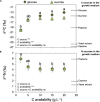The Free-Living Stage Growth Conditions of the Endophytic Fungus Serendipita indica May Regulate Its Potential as Plant Growth Promoting Microbe
- PMID: 33072023
- PMCID: PMC7536269
- DOI: 10.3389/fmicb.2020.562238
The Free-Living Stage Growth Conditions of the Endophytic Fungus Serendipita indica May Regulate Its Potential as Plant Growth Promoting Microbe
Abstract
Serendipita indica (former Piriformospora indica) is a non-obligate endophytic fungus and generally a plant growth and defence promoter with high potential to be used in agriculture. However, S. indica may switch from biotrophy to saprotrophy losing its plant growth promoting traits. Our aim was to understand if the free-living stage growth conditions (namely C availability) regulate S. indica's phenotype, and its potential as plant-growth-promoting-microbe (PGPM). We grew S. indica in its free-living stage under increasing C availabilities (2-20 g L-1 of glucose or sucrose). We first characterised the effect of C availability during free-living stage growth on fungal phenotype: colonies growth and physiology (plasma membrane proton pumps, stable isotopic signatures, and potential extracellular decomposing enzymes). The effect of the C availability during the free-living stage of the PGPM was evaluated on wheat. We observed that C availability during the free-living stage regulated S. indica's growth, ultrastructure and physiology, resulting in two distinct colony phenotypes: compact and explorer. The compact phenotype developed at low C, used peptone as the major C and N source, and displayed higher decomposing potential for C providing substrates; while the explorer phenotype developed at high C, used glucose and sucrose as major C sources and casein and yeast extract as major N sources, and displayed higher decomposing potential for N and P providing substrates. The C availability, or the C/N ratio, during the free-living stage left a legacy to the symbiosis stage, regulating S. indica's potential to promote plant growth: wheat growth promotion by the explorer phenotype was ± 40% higher than that by the compact phenotype. Our study highlights the importance of considering microbial ecology in designing PGPM/biofertilizers. Further studies are needed to test the phenotypes under more extreme conditions, and to understand if the in vitro acquired characteristics persist under field conditions.
Keywords: free-living stage; fungal phenotype; morphology; physiology; plant-growth-promoting-microbes; symbiosis stage.
Copyright © 2020 Dias, Pimentel, Cogo, Costa, Bertolazi, Miranda, de Souza, Melo, Carolino, Varma, Eutrópio, Olivares, Ramos and Cruz.
Figures






Similar articles
-
Maize Seedlings Colonization with Serendipita indica and Its Colonization Efficiency Analysis.Bio Protoc. 2023 Oct 20;13(20):e4855. doi: 10.21769/BioProtoc.4855. eCollection 2023 Oct 20. Bio Protoc. 2023. PMID: 37965269 Free PMC article.
-
High Ambient Temperature Regulated the Plant Systemic Response to the Beneficial Endophytic Fungus Serendipita indica.Front Plant Sci. 2022 Mar 16;13:844572. doi: 10.3389/fpls.2022.844572. eCollection 2022. Front Plant Sci. 2022. PMID: 35371134 Free PMC article.
-
Serendipita indica-A Review from Agricultural Point of View.Plants (Basel). 2022 Dec 7;11(24):3417. doi: 10.3390/plants11243417. Plants (Basel). 2022. PMID: 36559533 Free PMC article. Review.
-
The Abundance of Endofungal Bacterium Rhizobium radiobacter (syn. Agrobacterium tumefaciens) Increases in Its Fungal Host Piriformospora indica during the Tripartite Sebacinalean Symbiosis with Higher Plants.Front Microbiol. 2017 Apr 13;8:629. doi: 10.3389/fmicb.2017.00629. eCollection 2017. Front Microbiol. 2017. PMID: 28450855 Free PMC article.
-
The Role of Serendipita indica (Piriformospora indica) in Improving Plant Resistance to Drought and Salinity Stresses.Biology (Basel). 2022 Jun 23;11(7):952. doi: 10.3390/biology11070952. Biology (Basel). 2022. PMID: 36101333 Free PMC article. Review.
Cited by
-
Effect of samarium oxide nanoparticles on virulence factors and motility of multi-drug resistant Pseudomonas aeruginosa.World J Microbiol Biotechnol. 2022 Aug 30;38(11):209. doi: 10.1007/s11274-022-03384-4. World J Microbiol Biotechnol. 2022. PMID: 36040540
-
A bio-sustainable approach for reducing Eucalyptus tree-caused agricultural ecosystem hazards employing Trichoderma bio-sustained spores and mycorrhizal networks.Front Microbiol. 2023 Jan 16;13:1071392. doi: 10.3389/fmicb.2022.1071392. eCollection 2022. Front Microbiol. 2023. PMID: 36726567 Free PMC article.
-
Adoption of a novel medium for the industrial (3000 L) production of Serendipita indica employing a nutrient limitation strategy using insoluble carbon and phosphate sources.J Ind Microbiol Biotechnol. 2024 Dec 31;52:kuaf009. doi: 10.1093/jimb/kuaf009. J Ind Microbiol Biotechnol. 2024. PMID: 40246695 Free PMC article.
-
Synergistic Effect of Thymol-Ciprofloxacin Combination on Planktonic Cells and Biofilm of Pseudomonas aeruginosa.Curr Microbiol. 2023 Nov 29;81(1):23. doi: 10.1007/s00284-023-03546-z. Curr Microbiol. 2023. PMID: 38019310
-
Effects of various physicochemical parameters on the Biofilm formation and Pyocyanin production in Pseudomonas aeruginosa PA14.Biotechnol Lett. 2025 Aug 15;47(5):91. doi: 10.1007/s10529-025-03618-z. Biotechnol Lett. 2025. PMID: 40815394
References
-
- Achatz B., von Rüden S., Andrade D., Neumann E., Pons-Kühnemann J., Kogel K.-H., et al. (2010). Root colonization by Piriformospora indica enhances grain yield in barley under diverse nutrient regimes by accelerating plant development. Plant Soil 333 59–70. 10.1007/s11104-010-0319-0 - DOI
-
- Aslam M. M., Karanja J., Bello S. K. (2019). Piriformospora indica colonization reprograms plants to improved P-uptake, enhanced crop performance, and biotic/abiotic stress tolerance. Physiol. Mol. Plant Pathol. 106 232–237. 10.1016/j.pmpp.2019.02.010 - DOI
LinkOut - more resources
Full Text Sources

